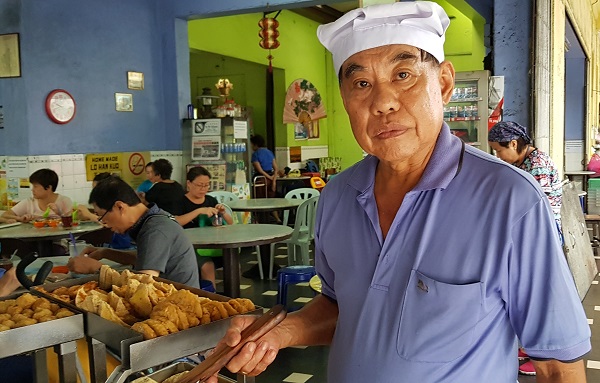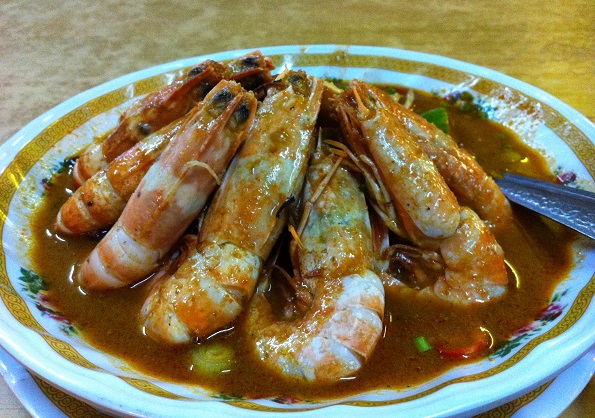A Wok Around Asia Guide to Penang Food
It’s a well-accepted fact that Malaysia produces some of the best street food in the world – however, different parts of Malaysia are famous for specific dishes, and Penang is no different.
How do you know what to eat if you’re visiting Penang for just a few days? Well, to help you decide, this is my pick of dishes that are uniquely Penang in flavour, cooking style and quality.
Note that this isn’t a where-to-eat as much as it’s a what-to-eat (with minor exceptions); here it is – my unordered list of dishes that are Penang-famous –
- Penang Char Koay Teow (or, as I spell it, Char Kway Teow) – the stir-fried rice noodle dish that’s often cooked with blood cockles, Chinese sausage and prawns; the version I grew up with in my part of Malaysia and which I’ve been selling for 20 years here in Sydney, is darker, sweeter and uses a wide-cut noodle and sometimes has wheat noodles added in; what you find in Penang is lighter in colour, more savoury, and uses a thin-cut noodle.

- Penang Char Koay Teow (or Char Koay Teow Basah ie. “Wet” Fried Rice Noodles) – this is probably the worst photo of this dish you’ll find anywhere but you’ll have to wait for my next trip to Penang to get an updated snap. I ate this in 2013 when on the road with a Malay TV crew while filming a Malay-language TV show in Malaysia. I ordered what was listed on a Malay eatery’s menu as “Penang Char Koay Teow” – and got this. It looks terrible but tastes delicious.
Because most Penang CKT (the famous version) are cooked by Chinese hawkers (ie. they’re not halal), many Malays (ie. Muslims) aren’t familiar with it; this Basah ie. “Wet” version is what THEY call Penang Char Koay Teow. I’ve had Malay people complain on my YouTube channel that the Penang CKT video I posted was wrong simply because their only experience of Penang CKT is this wet version. Confusing, I know, but trust me, if you get served this, don’t send it back to the kitchen, it’s very tasty.
- Char Kway Kak (Fried Radish Cake) – I, too, used to sell fried radish cake but it was listed on my menu as Chai Tow Kway, which is what it’s called in my part of Malaysia. Penang Char Kway Kak is dark and slightly sweet whilst the southern (Singaporean) Chai Tow Kway is light and very savoury; my version kind of splits the difference.

- Oyster Omelette (Or Chien) – Penang oyster omelette is soft and gooey, unlike the crispy variety you find in Thailand or Kuching, Sarawak (or for that matter, in Jalan Alor, Kuala Lumpur). I’ve also come across Prawn Omelette in Penang; same thing but with prawns instead of oysters.


- Chee Cheong Fun – Penang rice noodle rolls are different because the sauce that goes on them has some prawn paste in it (aka heiko; not belacan but the molassy sweet variety), which gives it a stronger flavour than the hoisin (ie. tim cheong) sauce you get with the dish elsewhere.

- Mee Jawa – I’m still on the fence regarding the Penang version of Mee Jawa (literally Javanese noodles) – but it’s notable because the sauce is completely different to what you’ll find in Kuala Lumpur, in that it’s quite tomato sauce-like.

- Nasi Kandar – this, to me, is Penang’s version of Nasi Campur (mixed rice) – it’s essentially a rice and curry buffet and the dishes that go with it can get quite elaborate; kandar refers to how this dish used to be sold in the early days – ie. where it was balanced on two ends of a bamboo pole and carried on the shoulders from place to place by Indian Muslim hawkers.


- Nyonya food – Penang Nyonya food is quite distinct from the Nyonya food in Melaka and Singapore; they use more sour flavours in their dishes compared to their southern counterparts, whose dishes are more rich and coconut-y.




- Nyonya kuihs ie. snacks – the Chinese and the Malays have their own takes on kuihs, but the Nyonyas are the ones who take it to the level of fine art with their famous attention to detail and masterful balance of flavours.



- Ais tingkap (window sherbet) – this refreshing drink is so named, I’m told, because it used to be sold from street windows back in the day.

- Peanut Biscuits – what I love about Penang is how it’s managed to preserve its old school ways of making food – I saw these two elderly gentlemen hard at work pounding peanut candy with a mallet one evening so I had to look them up. Turns out their business (spelled Ang Seng Hiang or Ang Seng Heong) is something of an institution in Penang, so keep your eyes peeled for their stalls.


Photo from the Penang Global Tourism FB page

Photo from the Penang Global Tourism FB page
- Hainanese Coffee and Kaya Toast – this is another example of keeping traditions alive – Toh Soon Kopitiam still cooks their toast on a charcoal grill. They keep a framed photo of the then-Penang Chief Minister (now Federal Finance Minister) Lim Guan Eng eating at their narrow five foot way stall; if it’s good enough for LGE, it’s absolutely good enough for me.


- Beef Noodle Soup – I was brought here courtesy of some very kind Penang locals but I have to admit the woman who ran the shop seemed highly antagonistic towards me, like I might have literally or figuratively stepped on her toes and not realised it. Nonetheless, credit where credit’s due, this is the best beef noodles I’ve eaten outside of my hometown of Seremban (where our beef noodle dish is world famous); this is the screenshot of their shop front and I’ve no idea what it says since I don’t read Chinese despite speaking a number of Chinese dialects.


- Lorbak or Loh Bak – variety of fried meat rolls and fritters with a chilli dip – I avoided this for many years since I don’t eat pork, but I’ve since found a number of non-pork options for it, and not a minute too soon. By the way, I stumbled upon this gentleman at his stall, took a pic then realised he was the same guy featured in a Penang cookbook I own; turns out he’s famous for his lorbak.



- Penang Asam Laksa – here in Australia (and in my part of Malaysia), the word “laksa” means a coconut curry-based noodle dish; in Penang, what they know as “laksa” is what we refer to as “Penang Asam Laksa” – which is a sour, fish-based soup with rice spaghetti/tapioca noodles which contains no coconut milk. In other words, order a “laksa” in Penang and this is what you get by default, which isn’t a bad thing because it’s listed among the top 5 street food dishes in the world.

- Penang Curry Mee aka White Curry Mee – this is the closest to what we know as “Laksa” – except the Penang version also typically contains coagulated pig’s blood and reconstituted dried squid.

- Siamese Laksa – I know the name makes it sound like it’s a Thai dish, but it’s in fact Penang-famous; this is like the best of both worlds between Penang Asam Laksa and our Curry Laksa; it contains all the fresh herbs and fish flavours of an asam laksa, but the soup is rich and creamy thanks to the addition of coconut milk.

- Mamak Mee Goreng and Mee Rebus – the Penang version uses a thinner egg noodle, but there’s more – this particular stall at Bangkok Lane cooks their noodles with stock made from simmering dried squid, and it’s one of the highlights of my latest Wok Around Asia trip.

Mee Rebus – literally, boiled noodles – comes with a thick sweet potato-based gravy

Mamak Mee Goreng, lit. fried noodles, mamak (Indian Muslim hawker)-style
- Wantan Mee or wonton noodles – the noodles used for this dish in Penang are thinner and silkier; one stall in particular uses two different sauces in it – the dark soy-based sauce, and a starchy, light sauce. Since yours truly doesn’t eat pork (hence no wontons or char siew), I ask for mine with shredded chicken and mushrooms.

- Rojak Buah – fruit salad with a prawn paste sauce – in Penang it comes with just fruit (mine used to contain fried yow char kway) and the sauce is less peanut-y than what you might find elsewhere.

- Pasembur – this is another one of those dishes where it means different things to cooks of different ethnic backgrounds; I personally love the version done by Chinese or Nyonya cooks, the sauce for which is lighter and more fruity-flavoured.



- Cendol – coconut and palm sugar dessert/drink with shaved ice and mung bean noodles; Penang is famous for the Teochew version of this drink, notable for its inclusion of red kidney beans.There’s a permanent line at the famous Macalister Lane stall that sells ais cendol, but I frequent the other one (pictured) in the same vicinity simply because I like supporting underdogs (they never have a line at that one).


- Penang Hokkien Mee – this is what we call Har Meen (ie. prawn noodles) in my part of Malaysia. The Penang version uses pureed prawn shells in the soup; I have to admit I save my cravings for prawn noodles for when I’m back in my own kitchen in Sydney because of the whole pork thing again (I use chicken bones, they use pork bones or a mix of pork and chicken).

- Mee Udang – ie. prawn noodles, Malay-style. Just as the Malays have their version of Char Koay Teow, they also have their version of Prawn Noodles which are completely different to the Chinese one. Malay prawn noodles are served in a thin gravy (rather than a soup) which is tomato sauce and prawn stock-based.

- Koay Teow Th’ng ie. rice noodles in clear soup with handmade fish balls; this is a very subtly-flavoured dish and it’s a favourite among Penang locals.

- Apom Manis – sweet crispy pancakes – these are one of my favourite childhood memories but back in Seremban they were sold by a Chinese hawker; here in Penang there’s a famous stall run by an Indian guy in Pulau Tikus, and he makes them on charcoal stoves.

- Putu Mayam – (a Penang local tells me she knows this as Putu Mayong) thin vermicelli with fresh grated coconut and palm sugar – the putu mayam I grew up eating uses a darker palm sugar than what I’ve found in Penang (so far), but I love that here in Penang, you can still find them being steamed fresh on upturned baskets at the Pulau Tikus wet market.

- Loh Mee – a noodle dish with a starchy dark sauce that I avoided like the plague for years because it’s typically made with pork; however, I came across one that’s pork-free and it is incredibly delicious, so much so I’ve been meaning to attempt making it at home.

- Nasi Melayu Pak Yusoff – honorable mention; this would be a typical Malay buffet-style stall ubiquitous in Malaysia, but for the fact that they are famous for their grilled fish, which are specially supplied by local fishermen and delivered every morning. Pretty cool.


Did I miss anything? Let me know, and I’ll add them to the list!
My Wok Around Penang project is made possible through the support of the following >>









